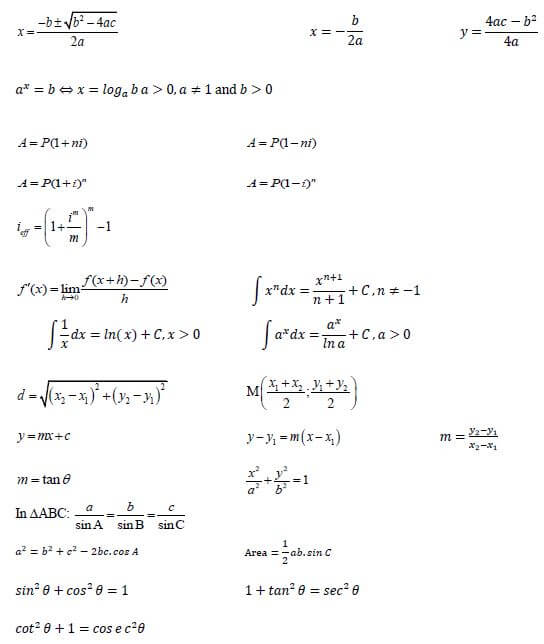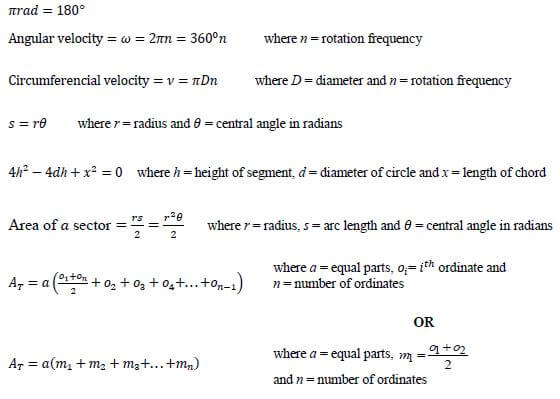TECHNICAL MATHEMATICS PAPER 2 GRADE 12 QUESTIONS - NSC EXAMS PAST PAPERS AND MEMOS JUNE 2019
Share via Whatsapp Join our WhatsApp Group Join our Telegram GroupTECHNICAL MATHEMATICS
PAPER 2
GRADE 12
NSC EXAMS PAST PAPERS AND MEMOS JUNE 2019
INSTRUCTIONS AND INFORMATION
Read the following instructions carefully before answering the questions.
- This question paper consists of 10 questions.
- Answer ALL the questions in the SPECIAL ANSWER BOOK provided.
- Clearly show ALL calculations, diagrams, graphs, et cetera which you have used in determining the answers.
- Answers only will NOT necessarily be awarded full marks.
- You may use an approved scientific calculator (non-programmable and non graphical) unless stated otherwise.
- If necessary, round off your answers to TWO decimal places, unless stated otherwise.
- Diagrams are NOT necessarily drawn to scale.
- An information sheet with formulae is included at the end of the question paper.
- Write neatly and legibly.
QUESTIONS
QUESTION 1
The diagram below is a parallelogram with vertices A(−2; 2); B(−4; − 1); C(2; 0) and D(x;y) α is the angle which AB forms with the x-axis. M(0; 1) is the midpoint of AC.
Determine: 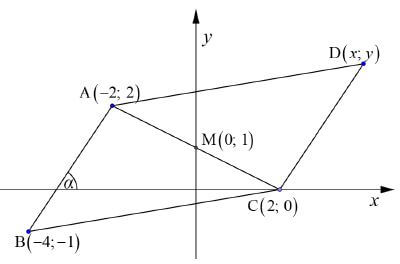
1.1 The length of AB (2)
1.2 The gradient of AB (2)
1.3 The equation of line DC in the form y = mx + c (3)
1.4 The size of α (rounded off to TWO decimal places) (2)
1.5 The y-coordinate of D (2) [11]
QUESTION 2
2.1 In the figure below, O is the centre of the circle. P and Q(12; 5) are two points on the circumference of the circle. POQ is a straight line. The point R lies on the tangent to the circle at Q. 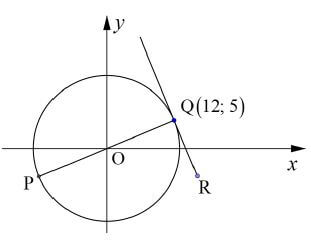
Determine the equation of:
2.1.1 The circle (2)
2.1.2 The tangent RQ in the form y = mx + c (4)
2.2 The equation of an ellipse, with centre at the origin is given by 9x2 + 16y2 = 144
2.2.1 Write down this ellipse equation in standard form (2)
2.2.2 Determine the length of the major axes and the minor axes respectively (2)
2.2.3 Draw on the grid provided, a neat sketch graph of the ellipse. Show ALL intercepts with axes and clearly indicate the major and minor axes (3) [13]
QUESTION 3
3.1 Use a calculator to determine the value of (rounded to 3 decimal places):
cosec2100º
-sec80º
3.2 Simplify to a single trigonometric function:
3.2.1 (7) (4)
(7) (4)
3.3 Prove the identity: (4) [17]
2 = 2cot2θ
secθsec(360º - θ) - tan45º
QUESTION 4
4.1 If 6 sin θ + 4 = 1 and cos θ > 0, draw a diagram on a Cartesian plane, showing the position of θ and evaluate without using a calculator:
4.1.1 tan θ (4)
4.1.2 sin θ + sec θ (3)
4.2 Solve for θ ∈ [0º; 360º], without using a calculator, if: 2sinθ − cosθ = 0 (5) [12]
QUESTION 5
In the diagram below, A, B and L are points on the same horizontal plane.
- HL is a vertical pole of 3 meters high.
- AL = 5,2 m.
- ALB = 113º and angle of elevation of H from B is 40º.
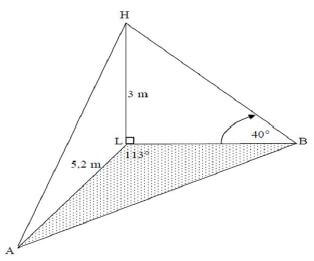
5.1 Determine the size of BHL. (1)
5.2 Calculate the length of LB. (2)
5.3 Hence or otherwise, determine the length of AB. (3)
5.4 Calculate the area of ∆ALB. (3) [9]
QUESTION 6
Given (x) = 2 cos x and g(x) = sin(x − 30°) for x ∈ [0°; 360°]
6.1 Draw the graphs of f and g on the same set of axes. Clearly show the intercepts with the axes as well as the turning points of the graphs. (6)
6.2 Write down the amplitude of f. (1)
6.3 Determine the period of g(x). (1)
6.4 What value(s) of x is g(x) ≤ 0? (4) [12]
Give reasons for ALL your statements in QUESTIONS 7, 8 AND 9. QUESTION 7
7.1 Complete the following theorems by writing down the missing word(s) in each case:
7.1.1 A line drawn from the centre of a circle to the midpoint of a chord, is … to the chord. (1)
7.1.2 Angles opposite equal sides in an isosceles triangle are … (1)
7.1.3 Opposite angles of a cyclic quadrilateral are … (1)
7.2 In the given diagram, O is the centre of the circle. Points A, C, B and E are on the circle. Diameter COE and chord AB intersect at right angles at D.
AD = DB = 15 cm and CD = 6 cm. 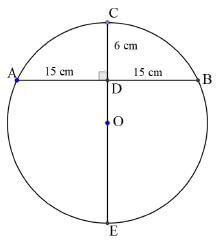
7.2.1 Calculate the length of DO. (4)
7.2.2 Calculate the size of AOB. (3)
7.3 The figure below models the wheel of a sport car with O the central point through which the axle of the car passes. The wheel touches the straight tared surface at point D only.
BC = DC and CDS = 40° 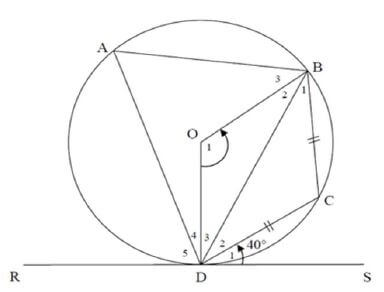
7.3.1 What geometric name is given to RS? Explain your answer. (2)
7.3.2 Determine the size of CDB. (3)
7.3.3 Calculate the size of B2. (3)
7.3.4 Determine the size of Â. (3) [21]
QUESTION 8
8.1 In the figure below, ΔPQR has TM|| QR, PQ = 28 mm and PM : MR = 4 : 3 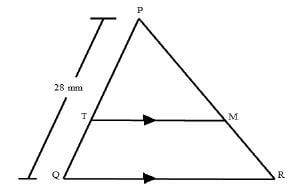
Determine the length of TQ. (4)
8.2 Below is the geometric model of a portion of a roof truss. In the model, ∆ABC has D and E on BC. BD = 6 cm and DC = 9 cm. AT : TC = 2 : 1 and AD // TE. 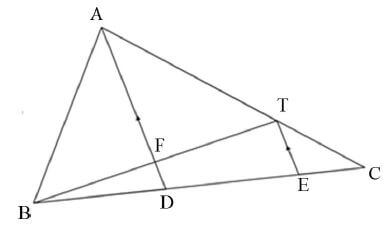
8.2.1 Write down the numerical value of CE/ED .(2)
8.2.2 Show that D is the midpoint of BE. (4)
8.2.3 If FD = 2 cm, calculate the length of TE. (4)
8.2.4 Calculate the numerical value of (3) [17]
Area of ∆ADC
Area of ∆ABD
QUESTION 9
9.1 In the figure below, a circle with centre O and OR ⊥ PT is given. Radius OB = 5 cm and PR = 4 cm. 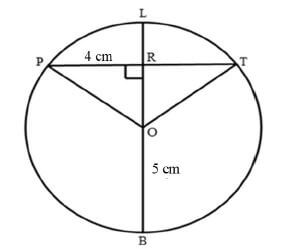
Calculate the heights of the segments of the circle. (5)
9.2 A mechanical technician needs to replace a cross belt on a lath machine as shown in the picture below. The two pulleys have radii of 35 and 85 respectively. The length of the driving belt A to F and C to D, which are points of contacts is 130 cm. 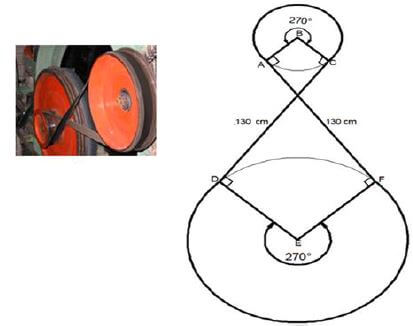
9.2.1 Calculate the length of the major arc DF, to the nearest integer. (4)
9.2.2 If the length of the major arc AC is 165 cm, determine the total length of the driving belt to be replaced. (2)
9.3 A pulley rotates at 420 r/min.
Calculate:
9.3.1 The angular velocity of the pulley in radians per second (4)
9.3.2 The circumferential velocity of the pulley in metres per second, if the diameter of the pulley is 240 mm (5) [20]
QUESTION 10
10.1 Consider the following cylinder and cone. Both objects have the same radius, r cm and height, h cm. ![]()
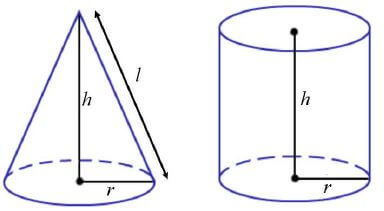
10.1.1 Express the slant height, l of the cone in terms of r and h. (1)
10.1.2 What is the relationship between the volumes of the objects? (1)
10.1.3 If the curved surface area of the cylinder and the cone are the same, πrl = 2πrℎ, show that r2 = 3ℎ2. (2)
10.1.4 Hence, express the volume of the cone in terms of h only. (2)
10.1.5 If the two volumes differ by 54π:
- Show that h = 3 (4)
- Find the value of r (2)
10.2 The map below represents a part of Southern Africa. Ordinates are drawn on the map such that the distance between the ordinates is 110 km. ALL measurements are in kilometres.
y1 | y2 | y3 | y4 | y5 | y6 | y7 | y8 | y9 | y10 | y11 |
430 | 793 | 1167 | 1475 | 1409 | 1431 | 1365 | 1205 | 870 | 529 | 347 |
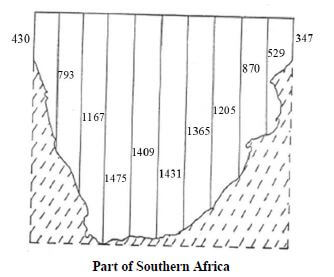
Determine:
10.2.1 The area of the region represented by the map, using the mid-ordinate rule (3)
10.2.2 The area of the shaded region (3) [18]
TOTAL: 150
INFORMATION SHEET: TECHNICAL MATHEMATICS 